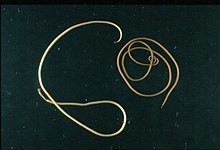 Wiki90
Wiki90
Wiki90: 90s Style Encyclopedia on the Web

|

|

|

|




Nematoida
Today, Nematoida is a topic of great relevance and interest to a wide spectrum of people in society. Its impact ranges from the personal to the global level, influencing decisions, trends and opinions. Nematoida has aroused the interest of researchers, academics, professionals and the general public, who seek to understand its implications, causes and possible solutions. In this article, we will explore different aspects related to Nematoida, analyzing its importance, evolution and debates that it currently generates.
| Nematoida Temporal range:
| |
|---|---|

| |
| Paragordius tricuspidatus | |
| Scientific classification | |
| Domain: | Eukaryota |
| Kingdom: | Animalia |
| Subkingdom: | Eumetazoa |
| Clade: | ParaHoxozoa |
| Clade: | Bilateria |
| Clade: | Nephrozoa |
| (unranked): | Protostomia |
| Superphylum: | Ecdysozoa |
| Clade: | Nematoida Schmidt-Rhaesa, 1996 |
| Phyla | |
| Synonyms | |
| |
Nematoida is a clade of pseudocoelomate free living or parasitic animals. It consists of phyla Nematoda and Nematomorpha. The two groups share a number of features in common; the presense of a cloaca in both sexes, aflagellate sperm, and a cuticle made of collagen.
Its position within Ecdysozoa is uncontroversial, but the identity of their closest relatives has been debated. Under the Cycloneuralia hypothesis, the nematoids are considered to be closest to Scalidophora, named for the ring-shaped brains found in these animals. However, this group has seen less support in phylogenetic analyses, with the Cryptovermes hypothesis being more consistently supported, which groups the nematoids with the panarthropods, although the issue is still not completely settled.
References
- ^ Poinar, George (January 2008). "Palaeonema phyticum gen. n., sp. n. (Nematoda: Palaeonematidae fam. n.), a Devonian nematode associated with early land plants". Nematology. 10 (1): 9–14. doi:10.1163/156854108783360159.
- ^ "articulata". Archived from the original on 2010-05-10. Retrieved 2009-06-28.
- ^ Telford MJ, Bourlat SJ, Economou A, Papillon D, Rota-Stabelli O (April 2008). "The evolution of the Ecdysozoa". Philos. Trans. R. Soc. Lond. B Biol. Sci. 363 (1496): 1529–37. doi:10.1098/rstb.2007.2243. PMC 2614232. PMID 18192181.
- ^ Telford MJ, Bourlat SJ, Economou A, Papillon D, Rota-Stabelli O (April 2008). "The evolution of the Ecdysozoa". Philos. Trans. R. Soc. Lond. B Biol. Sci. 363 (1496): 1529–37. doi:10.1098/rstb.2007.2243. PMC 2614232. PMID 18192181.
- ^ a b Telford, Maximillian; et al. (11 January 2008). "The evolution of the Ecdysozoa". Philosophical Transactions. doi:10.1098/rstb.2007.2243. PMC 2614232.
- ^ Hejnol, Andreas (2015). "Cycloneuralia". Spinger Link. doi:10.1007/978-3-7091-1865-8_1.
- ^ Howard, Richard. "The Deep Evolution of Ecdysozoa". ProQuest.
- ^ Howard, Richard; et al. (10 March 2022). "The Ediacaran origin of Ecdysozoa: integrating fossil and phylogenomic data". Journal of the Geological Society. doi:10.1144/jgs2021-107. hdl:2445/186596.
 Nematoida
Nematoida Nematoida
Nematoida Nematoida
Nematoida Nématozoaires
Nématozoaires Nematoida
Nematoida Nematoida
Nematoida

